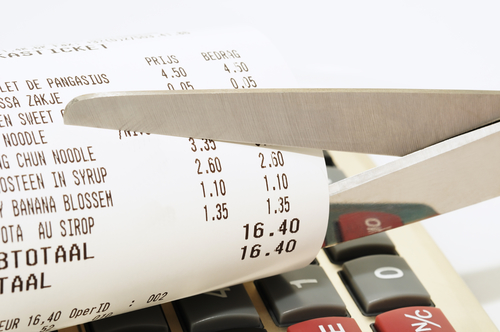- 26
- Apr
- 2018
Budget Vs. Nutrition
- Posted ByAdmin
- InCommunity, In the News

Economy concept with scissors cutting receipt from shop
Of course it is possible to eat well cheaply in America, but it takes resources and know-how that many low-income Americans don’t have. Kyera Reams of Osage, Iowa, puts an incredible amount of energy into feeding her family of six a healthy diet, with the help of staples from food banks and $650 in monthly SNAP benefits. A stay-at-home mom with a high school education, Reams has taught herself how to can fresh produce and forage for wild ginger and cranberries. When she learned that SNAP benefits could be used to buy vegetable plants, she dug two gardens in her yard. She has learned about wild mushrooms so she can safely pick ones that aren’t poisonous and has lobbied the local library to stock field guides to edible wild plants.
“We wouldn’t eat healthy at all if we lived off the food-bank food,” Reams says. Many foods commonly donated to—or bought by—food pantries are high in salt, sugar, and fat. She estimates her family could live for three months on the nutritious foods she’s saved up. The Reamses have food security, in other words, because Kyera makes procuring food her full-time job, along with caring for her husband, whose disability payments provide their only income.
But most of the working poor don’t have the time or know-how required to eat well on little. Often working multiple jobs and night shifts, they tend to eat on the run. Healthful food can be hard to find in so-called food deserts—communities with few or no full-service groceries. Jackie Christian didn’t resort to feeding her sons fried gizzards because it was affordable but because it was easy. Given the dramatic increase in cheap fast foods and processed foods, when the hungry have money to eat, they often go for what’s convenient, just as better-off families do.
It’s a cruel irony that people in rural Iowa can be malnourished amid forests of cornstalks running to the horizon. Iowa dirt is some of the richest in the nation, even bringing out the poet in agronomists, who describe it as “black gold.” In 2007 Iowa’s fields produced roughly one-sixth of all corn and soybeans grown in the U.S., churning out billions of bushels.
These are the very crops that end up on Christina Dreier’s kitchen table in the form of hot dogs made of corn-raised beef, Mountain Dew sweetened with corn syrup, and chicken nuggets fried in soybean oil. They’re also the foods that the U.S. government supports the most. In 2012 it spent roughly $11 billion to subsidize and insure commodity crops like corn and soy, with Iowa among the states receiving the highest subsidies. The government spends much less to bolster the production of the fruits and vegetables its own nutrition guidelines say should make up half the food on our plates. In 2011 it spent only $1.6 billion to subsidize and insure “specialty crops”—the bureaucratic term for fruits and vegetables.
Those priorities are reflected at the grocery store, where the price of fresh food has risen steadily while the cost of sugary treats like soda has dropped. Since the early 1980s the real cost of fruits and vegetables has increased by 24 percent. Meanwhile the cost of nonalcoholic beverages—primarily sodas, most sweetened with corn syrup—has dropped by 27 percent.
“We’ve created a system that’s geared toward keeping overall food prices low but does little to support healthy, high-quality food,” says global food expert Raj Patel. “The problem can’t be fixed by merely telling people to eat their fruits and vegetables, because at heart this is a problem about wages, about poverty.”
When Christina Dreier’s cupboards start to get bare, she tries to persuade her kids to skip snack time. “But sometimes they eat saltine crackers, because we get that from the food bank,” she said, sighing. “It ain’t healthy for them, but I’m not going to tell them they can’t eat if they’re hungry.”
The Dreiers have not given up on trying to eat well. Like the Reamses, they’ve sown patches of vegetables and a stretch of sweet corn in the large green yard carved out of the cornfields behind their house. But when the garden is done for the year, Christina fights a battle every time she goes to the supermarket or the food bank. In both places healthy foods are nearly out of reach. When the food stamps come in, she splurges on her monthly supply of produce, including a bag of organic grapes and a bag of apples. “They love fruit,” she says with obvious pride. But most of her food dollars go to the meat, eggs, and milk that the food bank doesn’t provide; with noodles and sauce from the food pantry, a spaghetti dinner costs her only the $3.88 required to buy hamburger for the sauce.
What she has, Christina says, is a kitchen with nearly enough food most of the time. It’s just those dicey moments, after a new bill arrives or she needs gas to drive the kids to town, that make it hard. “We’re not starved around here,” she says one morning as she mixes up powdered milk for her daughter. “But some days, we do go a little hungry.”
Crops Taxpayers Support With Subsidies
Federal crop subsidies began in the 1920s, when a quarter of the U.S. population worked on farms. The funds were meant to buffer losses from fluctuating harvests and natural disasters. Today most subsidies go to a few staple crops, produced mainly by large agricultural companies and cooperatives.
How Subsidized Crops Affect Diet
Subsidized corn is used for biofuel, corn syrup, and, mixed with soybeans, chicken feed. Subsidies reduce crop prices but also support the abundance of processed foods, which are more affordable but less nutritious. Across income brackets, processed foods make up a large part of the American diet.
